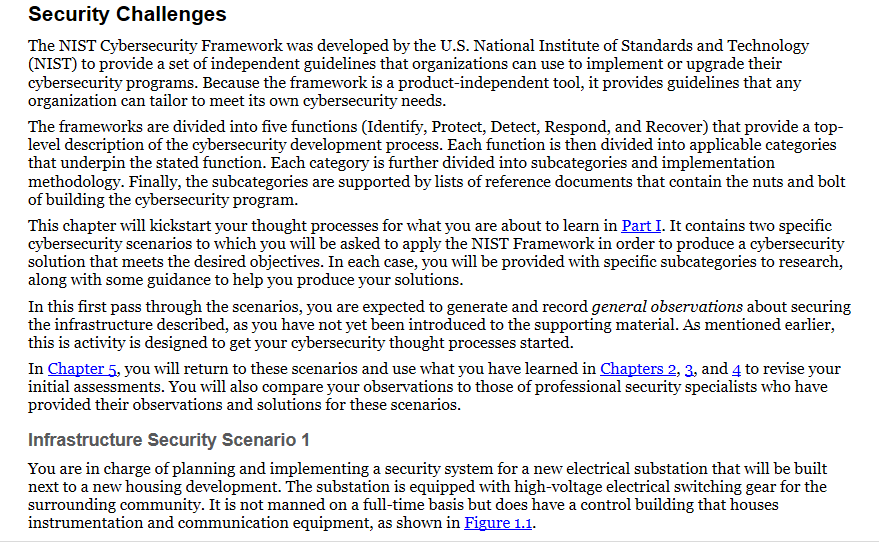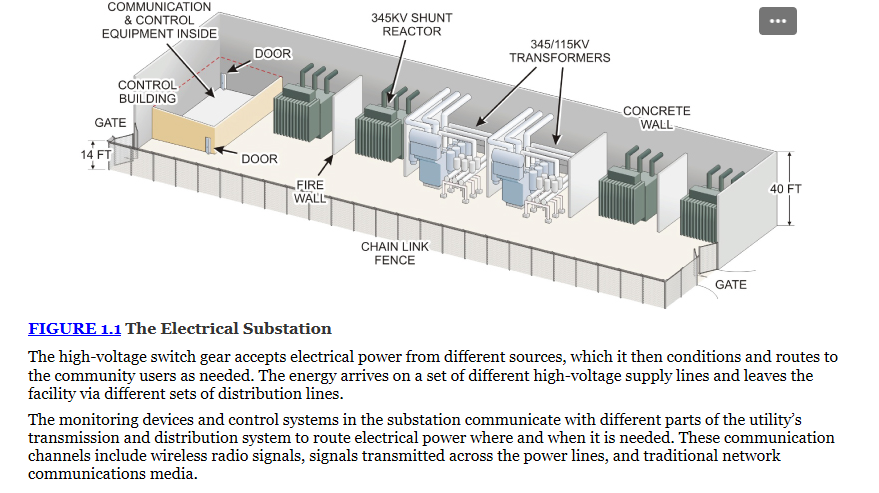What inventory of physical assets (devices and systems) created within the substation (NIST ID.AM-1)?
What inventory of physical assets (devices and systems) created within the substation (NIST ID.AM-1)?
Computer Networking: A Top-Down Approach (7th Edition)
7th Edition
ISBN:9780133594140
Author:James Kurose, Keith Ross
Publisher:James Kurose, Keith Ross
Chapter1: Computer Networks And The Internet
Section: Chapter Questions
Problem R1RQ: What is the difference between a host and an end system? List several different types of end...
Related questions
Question
Book title:
Chapter 1 - Infrastructure security in the Real world
From the information provided in the first scenario, consider the National Institute of Standards and Technology (NIST) functions detailed in this section and observe how they relate to each category.
1. What inventory of physical assets (devices and systems) created within the substation (NIST ID.AM-1)?
(Refer to screenshot for reference)

Transcribed Image Text:Security Challenges
The NIST Cybersecurity Framework was developed by the U.S. National Institute of Standards and Technology
(NIST) to provide a set of independent guidelines that organizations can use to implement or upgrade their
cybersecurity programs. Because the framework is a product-independent tool, it provides guidelines that any
organization can tailor to meet its own cybersecurity needs.
The frameworks are divided into five functions (Identify, Protect, Detect, Respond, and Recover) that provide a top-
level description of the cybersecurity development process. Each function is then divided into applicable categories
that underpin the stated function. Each category is further divided into subcategories and implementation
methodology. Finally, the subcategories are supported by lists of reference documents that contain the nuts and bolt
of building the cybersecurity program.
This chapter will kickstart your thought processes for what you are about to learn in Part I. It contains two specific
cybersecurity scenarios to which you will be asked to apply the NIST Framework in order to produce a cybersecurity
solution that meets the desired objectives. In each case, you will be provided with specific subcategories to research,
along with some guidance to help you produce your solutions.
In this first pass through the scenarios, you are expected to generate and record general observations about securing
the infrastructure described, as you have not yet been introduced to the supporting material. As mentioned earlier,
this is activity is designed to get your cybersecurity thought processes started.
In Chapter 5, you will return to these scenarios and use what you have learned in Chapters 2, 3, and 4 to revise your
initial assessments. You will also compare your observations to those of professional security specialists who have
provided their observations and solutions for these scenarios.
Infrastructure Security Scenario 1
You are in charge of planning and implementing a security system for a new electrical substation that will be built
next to a new housing development. The substation is equipped with high-voltage electrical switching gear for the
surrounding community. It is not manned on a full-time basis but does have a control building that houses
instrumentation and communication equipment, as shown in Figure 1.1.

Transcribed Image Text:COMMUNICATION
345KV SHUNT
& CONTROL
EQUIPMENT INSIDE
REACTOR
345/115KV
TRANSFORMERS
DOOR
CONTROL
BUILDING
CONCRETE
WALL
GATE
14 FT
DOOR
LFIRE
WALL
40 FT
CHAIN LINK
FENCE
GATE
FIGURE 1.1 The Electrical Substation
The high-voltage switch gear accepts electrical power from different sources, which it then conditions and routes to
the community users as needed. The energy arrives on a set of different high-voltage supply lines and leaves the
facility via different sets of distribution lines.
The monitoring devices and control systems in the substation communicate with different parts of the utility's
transmission and distribution system to route electrical power where and when it is needed. These communication
channels include wireless radio signals, signals transmitted across the power lines, and traditional network
communications media.
Expert Solution
This question has been solved!
Explore an expertly crafted, step-by-step solution for a thorough understanding of key concepts.
This is a popular solution!
Trending now
This is a popular solution!
Step by step
Solved in 2 steps

Recommended textbooks for you

Computer Networking: A Top-Down Approach (7th Edi…
Computer Engineering
ISBN:
9780133594140
Author:
James Kurose, Keith Ross
Publisher:
PEARSON

Computer Organization and Design MIPS Edition, Fi…
Computer Engineering
ISBN:
9780124077263
Author:
David A. Patterson, John L. Hennessy
Publisher:
Elsevier Science

Network+ Guide to Networks (MindTap Course List)
Computer Engineering
ISBN:
9781337569330
Author:
Jill West, Tamara Dean, Jean Andrews
Publisher:
Cengage Learning

Computer Networking: A Top-Down Approach (7th Edi…
Computer Engineering
ISBN:
9780133594140
Author:
James Kurose, Keith Ross
Publisher:
PEARSON

Computer Organization and Design MIPS Edition, Fi…
Computer Engineering
ISBN:
9780124077263
Author:
David A. Patterson, John L. Hennessy
Publisher:
Elsevier Science

Network+ Guide to Networks (MindTap Course List)
Computer Engineering
ISBN:
9781337569330
Author:
Jill West, Tamara Dean, Jean Andrews
Publisher:
Cengage Learning

Concepts of Database Management
Computer Engineering
ISBN:
9781337093422
Author:
Joy L. Starks, Philip J. Pratt, Mary Z. Last
Publisher:
Cengage Learning

Prelude to Programming
Computer Engineering
ISBN:
9780133750423
Author:
VENIT, Stewart
Publisher:
Pearson Education

Sc Business Data Communications and Networking, T…
Computer Engineering
ISBN:
9781119368830
Author:
FITZGERALD
Publisher:
WILEY